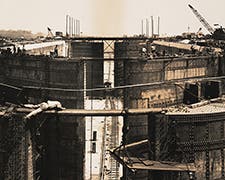Envisioning a Canal
Interest in an artificial waterway between the Atlantic and Pacific Oceans in the 19th century came from many directions. Alexander von Humboldt’s ideas on the subject were among the most influential, if for no other reason than for drawing attention to the question. Humboldt’s long essay on the topic of a canal across Central America appeared in his Political Essay on the Kingdom of New Spain, in 1811. By mid-century he had become one of the most famous people in the world, and his views on the importance of a canal became widely known.
Napoléon Garella, an engineer sent by the French government in 1843 to study the question of a route across the Isthmus of Panama, recommended a canal from Limon Bay to the bay of Boca del Monte, twelve miles west of Panama City. Nothing came of this proposal, as the project could not attract enough funding to go forward. The map published with Garella’s report, however, is remarkably detailed and clearly shows the route of his proposed canal.

